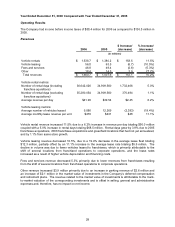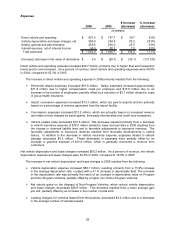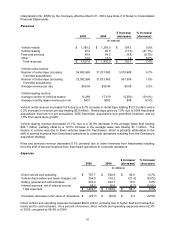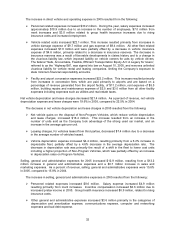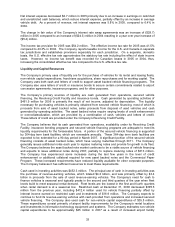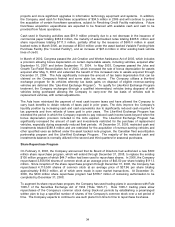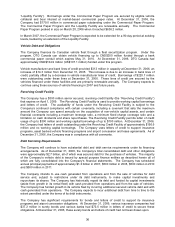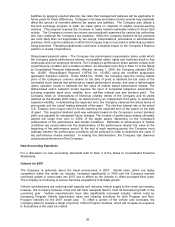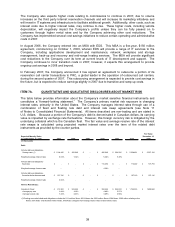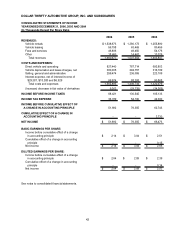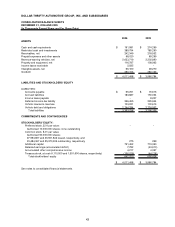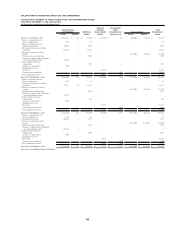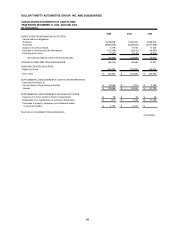Thrifty Car Rental 2006 Annual Report Download - page 44
Download and view the complete annual report
Please find page 44 of the 2006 Thrifty Car Rental annual report below. You can navigate through the pages in the report by either clicking on the pages listed below, or by using the keyword search tool below to find specific information within the annual report.liabilities by applying enacted statutory tax rates that management believes will be applicable to
future years for these differences. Changes in tax laws and rates in future periods may materially
affect the amount of recorded deferred tax assets and liabilities. The Company also utilizes a
like-kind exchange program to defer tax basis gains on disposal of eligible revenue-earning
vehicles. This program requires the Company to make material estimates related to future fleet
activity. The Company’s income tax returns are periodically examined by various tax authorities
who may challenge the Company’s tax positions. While the Company believes its tax positions
are more likely than not supportable by tax rulings, interpretations, precedents or administrative
practices, there may be instances in which the Company may not succeed in defending a position
being examined. Resulting adjustments could have a material impact on the Company’s financial
position or results of operations.
Share-based payment plans – The Company has share-based compensation plans under which
the Company grants performance shares, non-qualified option rights and restricted stock to key
employees and non-employee directors. The Company’s performance share awards contain both
a performance condition and a market condition. As discussed more fully in Note 13 to the Notes
to Consolidated Financial Statements, effective January 1, 2006, the Company adopted SFAS
No. 123(R), “Share-Based Payment” (“SFAS No. 123(R)”) using the modified prospective
application transition method. Under SFAS No. 123(R), the Company uses the closing market
price of the Company’s common shares on the date of grant to estimate the fair value of the
nonvested stock awards and performance based performance shares, and uses a lattice-based
option valuation model to estimate the fair value of market based performance shares. The
lattice-based option valuation model requires the input of somewhat subjective assumptions,
including expected stock price volatility, term, risk-free interest rate and dividend yield. The
Company relies on observations of historical volatility trends of the Company and its peers
(defined as the Russell 2000 Index), as determined by an independent third party, to determine
expected volatility. In determining the expected term, the Company observes the actual terms of
prior grants and the actual vesting schedule of the grant. The risk-free interest rate is the actual
U.S. Treasury zero-coupon rate for bonds matching the expected term of the award on the date
of grant. The expected dividend yield was estimated based on the Company’s current dividend
yield, and adjusted for anticipated future changes. The number of performance shares ultimately
earned will range from zero to 200% of the target award, depending on the Company’s
achievement of the performance and market conditions. Estimates of achievement of market
conditions are incorporated into the determination of the performance shares’ fair value at the
beginning of the performance period. At the end of each reporting period, the Company must
estimate whether the performance conditions will be achieved in order to determine the value of
the performance shares awarded. In making this determination, the Company has observed
actual past performance of the Company.
New Accounting Standards
For a discussion on new accounting standards refer to Note 2 of the Notes to Consolidated Financial
Statements.
Outlook for 2007
The Company is optimistic about the travel environment in 2007. Rental rates, which are highly
competitive within the rental car industry, increased significantly in 2006 and the Company expects
continued growth in rental rates into 2007 due to efforts by the industry to offset increased fleet costs.
The Company is continuing to pursue franchise acquisitions to facilitate growth.
Vehicle manufacturers are reducing total capacity and reducing vehicle supply to the rental car industry;
however, the Company believes it has and will have adequate fleet to meet its forecasted growth in the
upcoming year. Vehicle manufacturers have also significantly increased industry vehicle costs by
increasing Program Vehicle depreciation rates and lowering incentives for both Program and Non-
Program Vehicles for the 2007 model year. To offset a portion of the vehicle cost increases, the
Company plans to operate a larger proportion of Non-Program Vehicles, which will increase its exposure
to fluctuations in the used car market.
38


